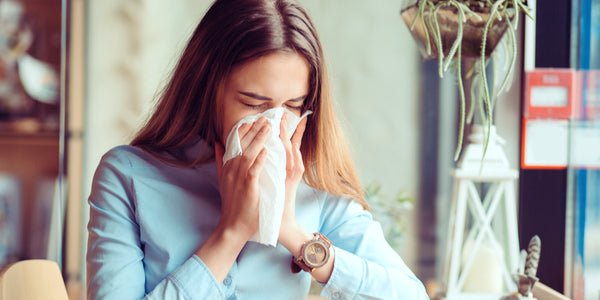
Runny nose? Nasal congestion?
Spring allergies may just be in the air!
If you struggle with seasonal allergies, managing those pesky symptoms is not out of the question.
Learn more about common spring seasonal allergy symptoms and the culprits that cause them. Also, find out how to manage symptoms before and when they arise.
Spring Allergies
Allergies are also known as allergic rhinitis, meaning a group of symptoms that affects the nose, and hay fever.
Symptoms occur when the body's immune system perceives a foreign substance as harmful. To protect itself, the body triggers an allergic reaction and releases chemicals such as histamine.
Allergies can be perennial (year-round) or seasonal (occurring in the early fall, spring, and summer.)
Allergy seasons can likewise depend on geographical location and climate changes, as mild winters and rainy springs can cause early pollination and plant growth.
Spring Allergy Culprits
Pollen and mold are the most common causes of spring allergies.
Pollen
Pollen is the male fertilizing agent of plants, trees, grasses, and weeds. Tree pollen allergies are the most common allergy triggers, especially at the beginning of spring.
Trees known to trigger spring allergies include:
• Ash
• Beech
• Birch
• Cypress
• Elm
• Hickory
• Maple
• Oak
• Poplar
• Sycamore
• Walnut
During the late spring and early summer, grass pollens are the main culprit. Grass pollens that often cause seasonal allergy symptoms include:
• Bermuda grass
• Orchard grass
• Timothy grass
Weed pollen is also a culprit of allergies, though it is most common in late summer and fall.
Mold
Mold is a type of fungi that can live virtually anywhere, including indoor basements and outdoor plants.
Their seeds, also known as spores, float in the air and become more prominent as temperatures rise in the spring. Allergic symptoms from these spores are most common from July to early fall
Pollen and mold counts can be influenced daily based on the following weather patterns:
• Pollens thrive during cool nights and warm days.
• Molds grow quickly in the heat and high humidity.
• Pollen washes away with the wind, though counts often increase following rain.
• Pollen counts increase on warm, windy days. On the flip side, allergens tend to be grounded on days without wind.
Common Spring Allergy Symptoms & Diagnosing
According to the American College of Allergy, Asthma & Immunology (ACAAI), common allergy symptoms include:
• A runny, stuffy nose
• Sneezing
• Itchy mouth, skin, or eyes
• Wheezing and shortness of breath
• A dry, persistent cough
• Rashes such as eczema, contact dermatitis, and hives
• Fatigue and irritability
• Headaches
Diagnosing spring allergies is generally not needed, as experiencing the symptoms is telling enough.
However, scheduling an appointment with an allergist or immunologist can be beneficial. They can pinpoint specific allergens even beyond spring culprits, including dust mites, pet dander, mold, medications, insect venoms, and various foods.
Knowing these allergens is useful for creating a custom prevention and treatment plan to mitigate symptoms and their severity.
How to Handle Your Allergies
Getting a handle on allergies can be the answer to an enjoyable spring, or any season for that matter.
Below outlines effective ways to stop allergies immediately, or at least right in their tracks as fast and much as possible.
Avoid allergens as much as possible.
While it may be challenging to avoid allergens altogether, there are ways to limit their exposure as much as possible. Tips to do include the following:
• Monitor daily pollen counts via resources such as pollen.com and weather apps.
• Avoid going outside when tree pollen is highest, often mid-morning through the mid-afternoon. This includes windy days, too.
• Keep windows closed, including in the home and car.
• Turn off indoor fans, as they can disturb settled allergens.
• Take off shoes and change clothes when re-entering your home.
• Shower, if possible, when coming inside from the outdoors.
• Avoid drying clothes on an outdoor clothesline.
• Bathe pets on a regular occasion, as their fur can trap allergens and bring them indoors.
• Spring clean and change air filters.
Take allergy medication.
Allergy medications help ease those pesky allergy symptoms. There are many types of allergy medications, including over-the-counter and prescription antihistamines, decongestants, and allergy shots.
Allergy medications come in various forms such as:
• Eye drops
• Liquids
• Nasal sprays
• Pills and capsules
Work with a doctor to find out which allergy medication might work best for you and your symptoms. They can also highlight safe dosing recommendations and potential side effects, including drowsiness caused by some antihistamines.
For allergy medications to work at their best, start them early. Getting ahead can lower the risk of symptoms emerging or at least easing their severity.
Consider diet factors.
Interestingly, diet can play a role in how allergies manifest themselves. There are notable foods that can worsen or improve allergy symptoms and their severity.
For instance, spicy foods can activate the immune system while apples, peaches, and other fresh fruits may contain tree pollens. These factors can cause and worsen allergy symptoms.
On the flip side, eating foods with anti-inflammatory properties can be beneficial. Adopting a Mediterranean diet, or some of its components, can help mitigate inflammation and offer allergy relief.
All-in-all, effective allergy management can defer from one person to the next. However, avoidance measures, medications, and dietary changes may offer relief desired to enjoy what each season has to offer!
References:
Allergic Rhinitis. ACAAI Public Website. https://acaai.org/allergies/types/hay-fever-rhinitis
Seasonal Allergies. ACAAI Public Website. https://acaai.org/allergies/seasonal-allergies





